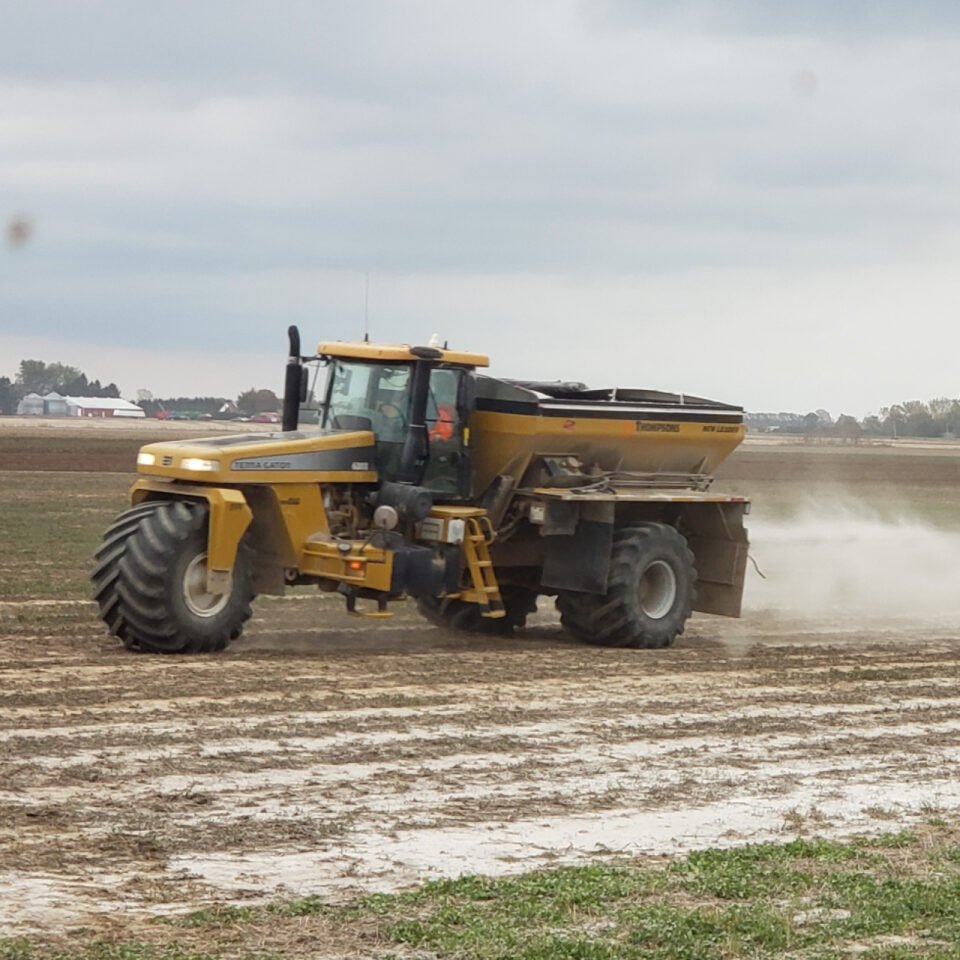
Soil sampling is a fundamental part of understanding and managing our soils, giving us some very useful information about their potential, including a measure of the soil’s pH. pH is a measure of soil acidity, and is incredibly important when it comes to macro and micronutrient availability, microorganism activity, and even the severity of some soil-borne disease organisms.
Aglime, or lime, is one of the most commonly used field amendments for acidic soils. Generally made from crushed and finely ground limestone, lime application is important to neutralize soil acidity by raising the pH level. Overly acidic (low pH) soils can decrease the availability of most essential nutrients to the plant, as well as stunt root growth and hinder plant development. Acidic soils occur when there are high levels of positively charged hydrogen ions held to the soil particles.
Here are some facts about pH, lime and its application:
- Soil pH is influenced by many factors, including decomposition of Organic Matter, parent material, precipitation, native vegetation, crops grown, soil depth, N fertilization, and flooding.
- Acidic soils can lead to elements such as Al or Fe to reach toxic levels, and can cause deficiencies in P, K, Ca, Mg, as well as N and S.
- Overly acidic soils are detrimental to the N-fixing bacteria in relationship with legumes such as soybeans or alfalfa.
- Some soil-applied residual herbicides have reduced efficacy when soil pH is too low.
- Soil pH determines whether or not lime is needed, but the Buffer pH determines how much lime is needed to correct soil acidity. Buffer pH measures how resistant the soil is to change, and it may require higher or lower rates to neutralize the soil.
- Soils with higher organic matter or clay content will take more lime to adjust pH than sandy soils, although will need applications less frequently to maintain pH.
- Lime can be over-applied, and in general raising pH past 7.0 can lead to reductions in yield, degradation of soil structure, and reduce P, Zn, B, and Mn availability. How much to apply, and where to apply it is critical to success and profitability.
- Lime needs time to react in the soil , therefore the best time to apply lime is in the fall after harvest, so it is given time to begin neutralizing the soil for the next year’s crop. Full benefit of the lime’s neutralizing can occur over 2-5 years as it reacts with the soil.
- Placement is important for the effectiveness of the lime. Maximum contact with plow layer of the soil is essential. The most commonly used liming materials are only slightly soluble in water so an even distribution throughout the soil is very important for a successful reaction to occur.
- Tillage equipment is the easiest way to mix lime in the soil, although no-till equipment can help lime work its way, albeit make it much slower to react.
- Low rate liming can be used in areas of slightly acidic pH, to address calcium deficiencies, and prevent large pH drops that would require larger amounts of lime.
- Utilizing Dolomitic Lime can aid in correcting magnesium deficiencies, while Calcitic Lime can be used in areas of high soil Mg.
- Nutriliming agents are a dual purpose material that raises pH and fertilizes in one application. KaLime is a nutri-liming agent available in Ontario, containing macro and micronutrients: Potassium (K), Calcium (Ca), Magnesium (Mg), Sulfur (S), Boron (B), Zinc (Zn), and Copper (Cu) that are finely ground and readily available to the crop.
Major benefits of Aglime (if required according to soil test):
- Improved soil structure and quality
- Increased nutrient availability
- Stimulated microbial activity in the soil
- Improved efficacy of herbicides
- Improved symbiotic N fixation by legumes
- Increased supply of Calcium and Magnesium
- Increased crop yields
Liming your soil is very important to maintain fertile and healthy soils, and can show significant yield and quality improvement in crops the seasons following the lime application. Improper soil pH can lead to weaker plant growth, and thus assist in introducing other pest issues such as nematodes, insects, or disease to the crop. Desirable soil pH can range depending on soil type and intended crops, but in general should be between 6.0 – 7.5 for most crops, 6.5 – 8.0 for legumes, or 5.0 – 5.5 for muck soils.
Soil pH will change in the field over time naturally, so it is recommended to soil test regularly, at least once every 3-4 years depending on crop rotation.
Additional Sources: IPNI Soil Fertility Manual 2006, Southern States